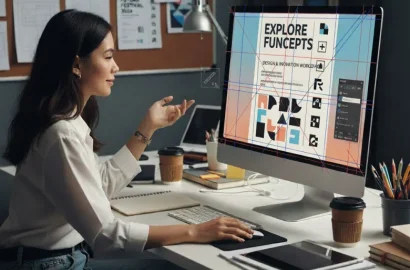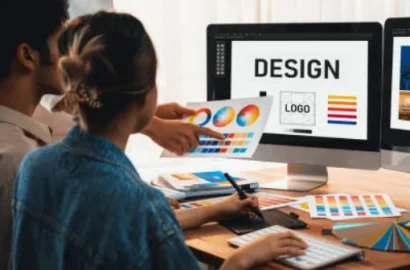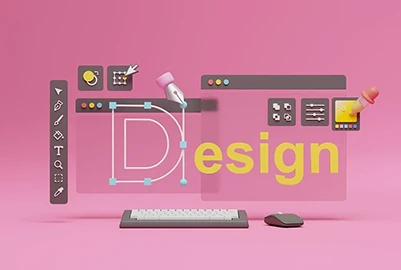Learn exactly what visual communication design is—and what it takes to become a visual communication designer—in this guide.
Visual communication design is the art of conveying ideas and information through visual media. It covers everything from posters, billboards, websites, and apps, to product packaging and book covers—to name just a few.
It’s an incredibly broad and versatile discipline. And, for those who work in the field, it offers great variety and creativity.
But what exactly is visual communication design? And what does a visual communication designer do?
We’ve covered everything you need to know in this ultimate guide, including:
- What is visual communication design?
- The different types of visual communication design
- Fundamental elements and principles of visual communication design
- What does a visual communication designer do?
- Potential jobs and career paths in visual communication design
- What skills does a visual communication designer need?
- How to become a visual communication designer
- Learn more about the design industry
Let’s jump in.

What is visual communication design? A definition
Visual communication design uses visual elements to communicate a certain idea, message, or piece of information.
Consider a billboard advert at your local bus stop, the packaging for your favorite food and drink products, or iconic brand logos. Those are just a few examples of visual communication design in action.
The purpose of visual communication design is to connect with the target audience in a way that’s visually engaging and appealing. This helps to make an impression, build familiarity, and inspire action—all depending on the context and the overall goal.
Indeed, visual communication design is a broad field with many different use cases. With that, let’s explore the different types of visual communication design.
The different types of visual communication design
There are three main types of visual communication design: digital, print, and environmental.
Within these main categories, visual communication design can be used for a variety of reasons—such as marketing and advertising, branding, or helping people navigate physical spaces.
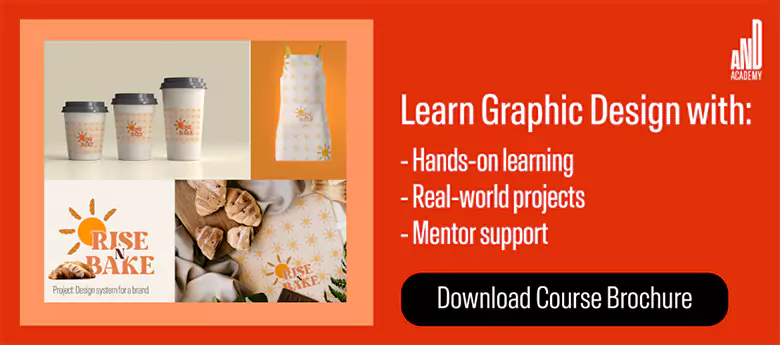
Here’s an overview of the different types of visual communication design.
1. Digital design
Digital visual communication design is all about creating content for digital platforms such as websites, apps, social media, and online advertising. It includes things like:
- UI UX design—designing the layout, aesthetics, and overall functionality for websites, apps, and software.
- Creating graphics, templates, and animations specifically tailored to certain social media platforms like Instagram, TikTok, and Facebook.
- Motion graphic design—creating animated elements for videos, advertisements, or presentations.
- Designing layouts and graphics for email newsletters, as part of a company’s broader digital marketing efforts.
- Digital advertising—creating online banners, pop-ups, and other visuals for digital ad campaigns.
2. Print design
Another type of visual communication design focuses on designing for print. This includes any design materials that are intended to be printed and distributed physically—such as magazine covers, posters, and product packaging.
Some common examples of visual communication design for print include:
- Editorial design—such as books, magazines, and newspapers.
- Printed marketing materials such as posters, flyers, brochures, and business cards.
- Packaging design—including things like labels, boxes, and product wraps.
- Invitations, banners, and programs for events.
- Typography design for posters and other printed artworks.
3. Environmental design
Environmental design is all about visual communication design for physical spaces, with the goal of helping people navigate and interact with the space—such as a shopping center, a car park, or a museum exhibit. It includes:
- Wayfinding and signage—designing directional signs for buildings, airports, and public spaces.
- Designing visual materials for museums, galleries, or trade shows.
- Creating branding materials for physical spaces, such as within a department store, an office, or a pop-up.
- Public art and installations such as murals, sculptures, or graphic elements in urban spaces.
- Event and stage design—creating visual elements for concerts, conferences, and performances.
As you can see, visual communication design is an incredibly broad discipline that spans a range of mediums and contexts. But, no matter what kind of visual communication design you focus on, there are some universal elements and principles that will shape your work. Let’s explore those now.

The fundamental elements and principles of visual communication design
Anyone working in visual communication design (or aspiring to do so) must be familiar with the following elements and principles.
1. The 7 key elements of visual communication design
These are the building blocks that visual communication designers count on to create aesthetically pleasing, engaging designs:
Typography
Typography is the art of designing, styling, and arranging letters and text. It includes things like font choice, size, weight, and spacing, and it impacts the overall readability, mood, and tone of the project.
Color
Another fundamental building block of visual communication design, color helps to establish visual hierarchy, evoke certain emotions in the target audience, and build a meaningful brand or visual identity. Visual communication designers use color theory and color psychology to determine appropriate color palettes for a given project.
Imagery
This includes things like photos, illustrations, and icons—anything that can add visual interest, enhance storytelling, and help to communicate the core message.
Layout and composition
This considers how different elements are arranged spatially on the page or screen. A well-designed layout and composition help create balance and structure, guide the viewer’s attention, and enhance usability (especially in the context of digital design).
Shapes and lines
Shapes and lines can be geometric, organic, or abstract (think: a triangle, a flower shape, or an abstract figure depicting a person). They help to direct the viewer’s attention, create emphasis, and build structure.
Space
Space is crucial in visual communication design, helping to prevent visual clutter, improve focus, and, in the context of digital design, make sure that clickable elements are easy to access and interact with.
Texture
Texture is used to convey a tactile quality (e.g. sandy, smooth, bumpy, and so on). It can help to add depth and contrast and bring a visual design to life.
2 The fundamental principles of visual communication design
The following principles guide how the elements of visual communication design are used to create cohesive, effective, and engaging designs:
Balance
This refers to the distribution of visual weight in a design. Balance can be symmetrical, asymmetrical, or radial depending on the effect you want to achieve.
Contrast
Contrast is used to create emphasis, add visual intrigue, and enhance readability. Visual communication designers create contrast through size, weight, color, texture, and white space.
Hierarchy
Organizing elements in order of importance helps to guide viewers so that they perceive the most important information first. You’d place an important heading at the top of the page, for example, with secondary text lower down.
Alignment
Alignment ensures that individual elements are visually connected, creating a sense of order and cohesiveness. This helps with both aesthetic appeal and readability.
Repetition
By repeating certain elements such as colors, fonts, or patterns, visual communication designers can create consistency and, in the case of branding, reinforce the brand’s visual identity.
Proximity
This is when similar or related items are grouped together to tell the viewer that these elements should be perceived as belonging to the same category.
Unity
Unity refers to the overall harmony of the design. When creating designs, it’s important to ensure that all design elements work together to create a unified whole.
Scale and proportion
This refers to the size of individual elements relative to one another. Keeping elements in proportion creates a sense of harmony while exaggerating certain elements or breaking the rules of proportion can be used to convey humor and playfulness within a design.
Movement
The movement principle considers how the viewer’s eye moves across the design. When creating designs, it’s important to think about the pathway the viewer will take—and how you can steer them with your design choices.
If you’d like to learn more about each principle, refer to this practical guide: 12 Fundamental Graphic Design Principles and How to Apply Them.
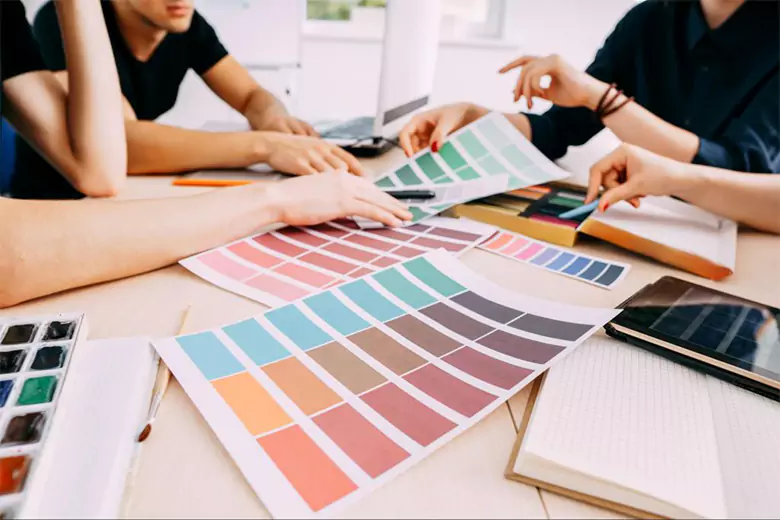
What does a visual communication designer do?
A visual communication designer is responsible for creating visual content that engages the target audience and communicates a specific message. They’re the specialists behind every example of visual communication design you see—be that a billboard, a banner ad, or a beautifully designed product box.
They combine creativity and technical skills to understand the project goals, brainstorm ideas, and develop design concepts. They then use the fundamental elements and principles of visual design to bring those concepts to life.
It’s important to note that the exact role of a visual communication designer varies depending on their niche. A designer working in print will use different tools and techniques than a UX designer, for example.
We’ll explore specific job titles and career paths in the next section. First, let’s consider the main tasks and responsibilities that most visual communication designers will take on.
Key tasks and responsibilities of a visual communication designer
1. Defining the project goals and the target audience
Every visual communication design project has a specific goal—whether it’s promoting an event, encouraging people to buy a certain product, or raising awareness.
As such, the first task of a visual communication designer is to understand the project’s main objectives and figure out who they’re designing for and why.
This involves working closely with clients or internal stakeholders, getting familiar with the brand identity, and researching the target audience. They may also research trends, competitors, and cultural factors that can influence design choices.
2. Developing visual design concepts
With the project goals and target audience in mind, visual communication designers must come up with ideas and translate them into visual concepts.
This involves brainstorming different ways to effectively communicate the core message and creating sketches and mockups to visualize ideas.
As part of this process, visual communication designers are also responsible for considering individual design elements such as typography, color schemes, imagery, and layout.
3. Creating designs for various platforms
In addition to developing creative concepts, visual communication designers are also responsible for bringing that vision to life.
To do this, they create visuals that are suited for the intended channels and platforms—be that websites and social media, print materials, or physical signage.
4. Collaborating with clients and stakeholders
Visual communication design is highly collaborative. As such, designers often work closely with multiple stakeholders such as clients, marketers, developers, copywriters, and printers (depending on the type of visual communication design).
Through regular brainstorming sessions, feedback rounds, and ongoing communication, designers can ensure that the final output aligns with the overall project goals.
5. Maintaining brand consistency
Besides completing individual projects, visual communication designers may also be responsible for defining, developing, and maintaining the company or client’s brand identity.
They might have a hand in creating visual style guides, as well as designing individual brand elements such as logos, color palettes, and typography.
We’ve explored the general responsibilities of a visual communication design professional. But, as we mentioned earlier, there are many more specific roles within this broader discipline—so let’s consider those now.

Potential jobs and career paths in visual communication design
Visual communication designers work in a great variety of industries—from advertising and marketing to tech and software, publishing, film and TV, and the nonprofit sector (to name just a few).
If you’re considering a career in visual communication design, it’s important to be familiar with the different niches, roles, and pathways within the field.
Here are some of the most popular visual communication design job titles, with a summary of what each entails.
1. Graphic designer
Graphic designers create visual designs for print and digital media—such as logos, advertisements, brochures, and social media content. They’re responsible for all the visual elements of a project, from typography and color to imagery, composition, and layout.
Graphic designers are most commonly hired by marketing agencies and in-house creative teams, or they might work on a freelance basis for multiple clients.
Learn more about becoming a graphic designer:
- The Ultimate Guide to Graphic Design Salaries
- What Is Graphic Design and What Does a Graphic Designer Do?
- How To Become a Graphic Designer
2. UI UX designer
Another popular niche for visual communication designers is UX and UI design. UI and UX designers focus on creating user-friendly digital experiences for websites, apps, and software.
UI designers handle the aesthetics and interactive properties, while UX designers focus on the product’s overall structure and usability. Both roles require problem-solving, creativity, and collaboration.
UX and UI designers can find work in pretty much any company that offers some kind of digital product or service—be that in tech, banking, education, or nonprofit.
Learn more about working in UX and UI:
- The Top 10 UI UX Designer Jobs (and Their Salaries)
- How To Learn UI UX Design: A Step-by-Step Guide
- 15 Must-Have UI UX Design Skills and How To Develop Them
3. Motion graphics designer/animation designer
Motion graphics designers and animation designers create animated visual content that brings ideas to life through movement.
They create explainer videos, advertisements, title sequences, and dynamic web content. While motion graphics emphasize design elements like typography and shapes, animation designers may delve into character animation and storytelling.
They are commonly employed in video production studios, advertising agencies, gaming companies, and entertainment studios. Many also work as freelancers, collaborating on projects ranging from corporate videos to film and television productions.
Learn more:
- A Complete Guide to Motion Graphic Design
- An Expert Interview With AND Academy Mentor Shaaz Ahmed: Motion Graphic Design and Animation FAQs
- What Is Animation Design and What Does an Animation Designer Do?
We’ve covered just a handful of potential career paths in visual communication design. Additional graphic design job titles include brand identity designer, environmental designer, art director, packaging designer, and illustrator.
If you’d like to discover even more roles within the design industry, check out this guide: The Top Design Jobs in 2025 (and Their Salaries).
What skills does a visual communication designer need?
No matter what area they specialize in, visual communication designers rely on a combination of creative, technical, and interpersonal skills to excel in their field.
Here are some of the most important skills that employers will look for when hiring a visual communication designer.
1. The top technical skills for a visual communication designer
Visual communication designers must be able to demonstrate technical expertise and proficiency in the following:
- Industry-standard design software and tools such as Adobe Photoshop, Illustrator, InDesign, After Effects, and Figma.
- Typography: Knowledge of how to use fonts, spacing, and hierarchy to create readable, visually appealing text.
- Color theory: Visual communication designers must understand how color influences mood, perception, and brand identity, as well as how to create on-brand color palettes.
- Layout and composition: The ability to arrange text, imagery, and other elements cohesively for maximum visual impact and clarity.
- Digital design skills: If they’re working in the digital realm, visual communication designers must be proficient in digital design concepts and principles such as responsive design, accessibility, wireframing, and prototyping.
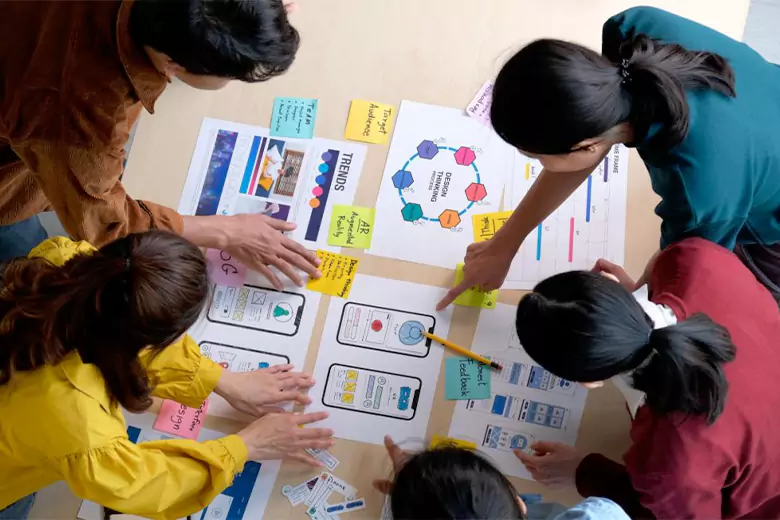
2. The most important creative skills for a visual communication designer
Employers will also look for skills in the following creative areas:
- Concept development: The ability to brainstorm and develop unique ideas that align with the project’s goals and the overall brand identity.
- Storytelling: Using visuals to effectively convey a specific message and tell a compelling story that engages the target audience.
- Problem-solving: Addressing design challenges creatively and strategically to meet project goals and make the best use of available resources.
3. The top interpersonal skills for a visual communication designer
Last but not least, employers will prioritize certain soft skills. Visual communication designers should demonstrate:
- Effective collaboration: The ability to work well with clients and stakeholders from various departments, including copywriters, developers, and marketers.
- Excellent communication: The ability to articulate ideas clearly, present design concepts, and both give and receive constructive feedback.
- Time management: The ability to manage multiple projects and meet deadlines without compromising on quality.
How to become a visual communication designer
Are you thinking about becoming a visual communication designer? Here are some practical steps to get you started.
1. Build a strong foundation through independent study and free resources
The first step is to explore the basics of visual communication design independently.
Start by understanding core principles like color theory, typography, layout, and composition. At the same time, familiarize yourself with the different pathways within the field, whether that’s graphic design, motion graphics, UI/UX, or environmental design.
Take advantage of free online resources such as blogs, YouTube tutorials, and short courses. These resources will help you get comfortable with design concepts, tools, and terminology at your own pace.
This self-guided learning phase helps you gain a solid understanding of the field—and may get you thinking about what specific areas of visual communication design spark your interest.
Not sure where to start? Check out these free resources:
- 7 Free Graphic Design Courses To Consider in 2025
- 9 Free Courses To Learn UI UX Design
- The Best Free Adobe Illustrator Courses for Beginners
2. Deepen your expertise with a professional course
Once you’ve gained an understanding of the basics, consider enrolling in a professional design course.
Whether through a degree program, a specialized design school, or an online certification, formal education provides a structured approach to learning the advanced skills and theories required for a career in visual communication design.
A well-rounded course will teach you critical design principles, advanced graphic design software skills, and creative problem-solving techniques.
You’ll also gain practical experience working with industry-standard tools like Adobe Creative Suite and build a portfolio to showcase your work.
Not only that: formal education also offers opportunities for collaboration, networking, and receiving feedback from experienced professionals, which will prove invaluable as you move forward in your career.

Check out AND Academy’s graphic design courses, or review our round-up of the best graphic design programs here.
3. Consider where you want to specialize and learn additional skills
As you build out your design skill set, it’s important to look ahead and think about where you might like to specialize. As we’ve explored throughout this post, visual communication design encompasses a wide range of specialist pathways. Narrowing your focus will allow you to concentrate on the area(s) you’re most passionate about.
You might find yourself drawn to digital design—in which case, you’ll want to focus on learning specific UI/UX design skills. If you’re keen to focus on visual communication design for marketing, you’ll want to tailor your skills to that niche.
By choosing a specialization, you can deepen your expertise in a particular area. This will enable you to build a strong portfolio and effectively market yourself to potential employers. We recommend you check out this visual identity project by Anjali Bothra, an AND learner, for inspiration.
Learn more about the design industry
We hope you’ve enjoyed learning about visual communication design. And, if that’s where your career aspirations lie, you feel empowered to start learning fundamental design skills and launch your career in the field.
For further insights and inspiration, we can recommend the following:
- 14 Well-Known Graphic Designers Everyone Should Follow for Inspiration
- From Economics to Graphic Design: How Amara Transformed Her Career
- From Civil Engineering To Design: Monica’s Career-Change Story
Next Steps
Additionally, here are some more resources you can consider:
- Watch this session by design veteran and AND’s Academic Head, Prachi Mittal, and our Course Lead, Soumya Tiwari.
- Talk to a course advisor to discuss how you can transform your career with one of our courses.
- Pursue our Graphic Design courses – all courses are taught through live, interactive classes by industry experts, and some even offer a Job Guarantee.
- Take advantage of the scholarship and funding options that come with our courses to overcome any financial hurdle on the path of your career transformation.
Note: All information and/or data from external sources is believed to be accurate as of the date of publication.




